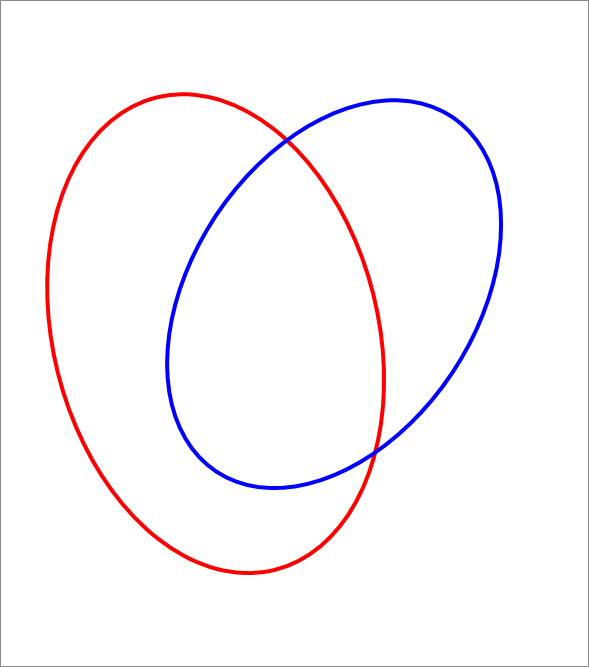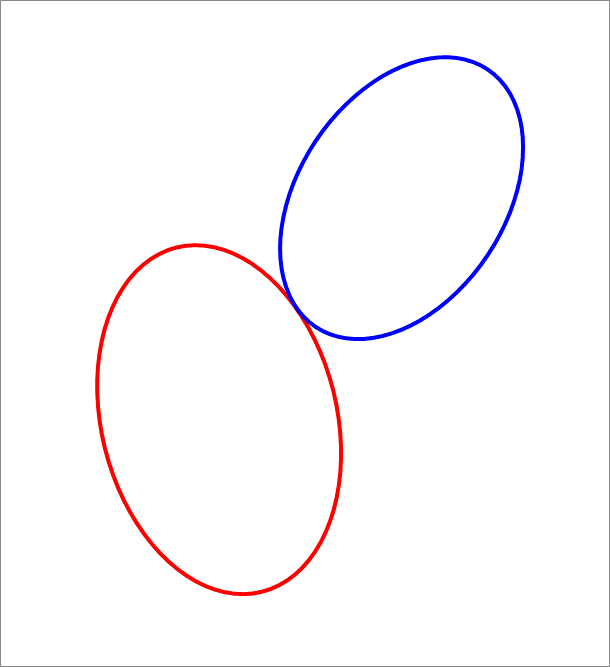Shifting an Ellipse to Tangency

The above figure shows two ellipses. The first one (in red) is centered at
and its semi-axes are congruent with the vectors
and
. The second one (in blue) is centered at
and its semi-axes are congruent with the vectors
and
. We want to shift the blue ellipse along the direction vector
such that it becomes tangent to the red ellipse. This is accomplished by moving its center to a new location
, where
and
is the unit vector along
; that is,
. Find the value of
, which is the distance travelled by the center of blue ellipse to the final location, rounded to 3 decimal places. Note that the semi-axes orientations are kept unchanged. The figure below shows the final relative position of both ellipses.

The answer is 7.523.
This section requires Javascript.
You are seeing this because something didn't load right. We suggest you, (a) try
refreshing the page, (b) enabling javascript if it is disabled on your browser and,
finally, (c)
loading the
non-javascript version of this page
. We're sorry about the hassle.
Let r be a point on the first ellipse, then
r = v 0 + V u , where V = [ v 1 , v 2 ] and u is a unit vector , i.e. u = [ cos θ , sin θ ] T .
From this, it follows that,
u = V − 1 ( r − v 0 ) .
Upon imposing the unit length condition of vector u , the familiar equation of an ellipse results, namely,
( r − v 0 ) T Q 1 ( r − v 0 ) = 1
where Q 1 = V − T V − 1
Similarly, the algebraic equation of the second ellipse is
( r − ( w 0 + t d ^ ) ) T Q 2 ( r − ( w 0 + t d ^ ) ) = 1
where, Q 2 = W − T W − 1 , and W = [ w 1 , w 2 ] .
At tangency, since the points on the first ellipse are external to the second ellipse, except for a single point which is the point of tangency, we have
( v 0 + V u − ( w 0 + t d ^ ) ) T Q 2 ( v 0 + V u − ( w 0 + t d ^ ) ) ≥ 1
The left-hand side of the equation is a function of θ and t ∗ , and at the point of tangency this function becomes equal to 1, and this
is its minimum, and hence, at this point, its derivative with respect to θ is zero. Hence, we have two scalar equations in two unknowns: θ ∗ and t ∗ . These are,
( v 0 + V u ∗ − ( w 0 + t ∗ d ^ ) ) T Q 2 ( v 0 + V u ∗ − ( w 0 + t ∗ d ^ ) ) = 1
and
( v 0 + V u ∗ − ( w 0 + t ∗ d ^ ) ) T Q 2 V d θ d u ∗ = 0
One convenient way to solve this system of equations is by the multi-variate Newton-Raphson method. The algorithm is very fast, and in the case of this problem, it converged to the solution in 5 iterations. The solution vector was ( θ ∗ , t ∗ ) = ( 0 . 5 2 4 8 5 , 7 . 5 2 3 4 5 ) . Therefore, the answer is 7 . 5 2 3 .